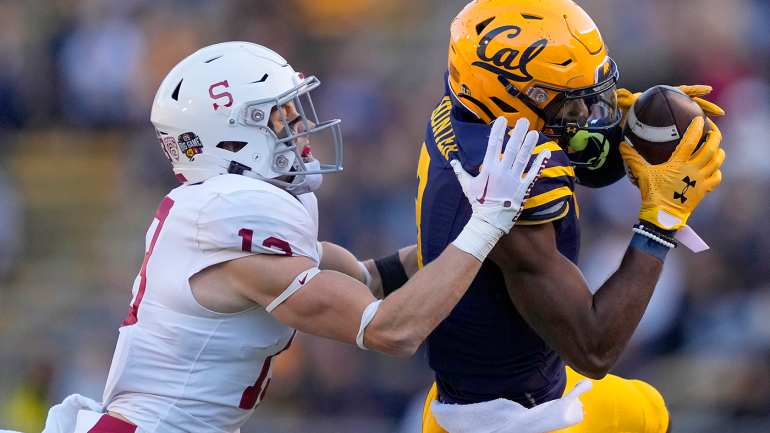
In many ways, this upcoming round of conference realignment is more uncertain than the last one. At least last time -- all the way back to earlier this month -- we knew the participants, where the money was going and who was throwing it around.
Consider this rarity as the four remaining Pac-12 schools try to figure out where they'll be playing in 2024: The priority for California, Stanford, Oregon State and Washington State -- at the moment -- isn't money.
In fact, for perhaps the first time in realignment, Power Five schools are assured of losing money by changing conferences. That's a function of the Pac-12 all but dissolving and the remaining Pac-4 having limited options.
The priority now is finding a conference to call home in 2024. Clearly, Oregon State and Washington State have little value -- at least compared to the $21 million they are set to earn in the last year of the Pac-12 contract. It's almost assured they won't match that sum no matter where they end up.
The Mountain West and American are both in competition for any combination of the Pac-4. The MWC pays schools approximately $4 million per year in media rights with three years left to go on its deal with CBS and Fox. The AAC pays approximately $7 million per school and has 10 years to remaining on its deal with ESPN.
In both cases, rightsholders for those conferences would have to go back to affiliates and ask for additional subscription fees.
Stanford, and perhaps Cal, might have a bit more juice than the others, but it's doubtful rightsholders will pay much more for those four brands. The Bay Area schools came one vote shy of landing a spot in the ACC last week where a full media rights share approaches $40 million annually. (It's possible Stanford and Cal, if approved, would have been offered less than a full share annually.)
So, what is the priority these days? Branding. That's why the best rivalries in the game (arguably) reside in the 34 teams that comprise the Big Ten and SEC beginning in 2024.
That highlights suggestions within the industry that realignment has reached a sort of critical mass. Not that it's over forever; it's over for now.
Industry sources repeat that there is not much desire by either conference to add the likes Clemson, Florida State, etc. Not that the ACC's seemingly "ironclad" grant of rights agreement would allow such movement.
That says loads about the reality of the market compared to how those schools view themselves.
Down the food chain, survival -- not a big payday -- becomes key.
Even if Oregon State and Washington State get admitted to the Mountain West for the current $5 million payout, that's an extra $10 million per year that CBS and/or Fox would have to shell out.
(It is debatable whether the Pac-4 create incremental value for existing rightsholders in the MWC, currently the dominant Group of Five conference. MWC sources would not comment whether the league might have to turn to a streaming partner, such as Apple, to get a deal done.)
The reality: No matter what happens in realignment, those schools will be forced to undergo massive budget cuts just to survive in the FBS. Washington State already faces an $11.5 million annual athletic shortfall. Even Cal, which might be able to slide into the ACC if the temperature changes, needs a massive amount of institutional support for athletics and faces annual debt service on stadium renovations.
The situation might be different in the American where schools currently earn slightly more with ESPN as the partner. Despite plenty of reports about cost-cutting, realignment presents the possibility for ESPN to get more games in that fourth broadcast window (10 p.m. ET or later). It has seen that inventory disappear with the dissolution of the Pac-12, though Arizona and Arizona State took some of those windows with them to the Big 12.
Would a couple dozen additional games involving a Cal, Stanford, Oregon State and Washington State be worth the additional outlay? It's not exactly a murder's row.
That makes it time to ask whether rightsholders are simply tapped out. A combination of reckless realignment and budget realities have forced networks to look at the bottom line.
For the last 30 years, media rights for the Big Ten and SEC have grown at a compounded annual rate of 10%. The Pac-12 spent the last year coming to the reality that a linear partner wouldn't touch it.
None of this is to suggest the remaining Pac-4 won't find a home. It is to suggest we are witnessing the bottom of the barrel in terms of media rights to the point that schools might -- for the first time -- have to reduce their revenue to survive in realignment.
Where Stanford, Cal stand with the ACC
If the ACC doesn't work out as a landing spot, Stanford has some reckoning to do.
It is one of the most prestigious collegiate institutions in the world. A big part of that is a broad-based athletic department that gushes the athletic/academic ideal. But does it place enough emphasis on winning championships in the major sports? That question has been asked by more than those outside the department.
There appears to remain some reciprocal interest between Stanford, Cal and the ACC. However, the Bay Area schools last week fell one vote short of being approved for inclusion in the league, sources told CBS Sports' Matt Norlander. Expansion in the ACC requires a yes vote from 75% of presidents (12 of 15), but Clemson, FSU, North Carolina and NC State voted nay.
The irony has not been lost on a lot of folks that Stanford and Cal are leveraging their world-class academic reputations in an attempt to join the ACC and stay relevant in football and basketball.
It's that or play in the same conference as teams like San Jose State, Fresno State, UTSA, East Carolina and FAU. Nothing against those schools from the MWC and AAC, of course.
That presents a massive decision for Stanford going forward: move one of the world's best-known higher education brands to a Group of Five conference, wait out the ACC or perhaps consider independence in football.
In one sense, it should not be a big deal. Stanford's wide swath of sports currently compete in five different conferences.
But there are reasons Stanford wasn't carried forward to the ACC or Big Ten. The latter did not consider the Bay Area market as a relevant-enough media market. That led both schools to scramble, geographical absurdities be damned. With Clemson, FSU and Miami (among others) complaining about ACC revenue, Stanford and Cal simply didn't rate a full share. Plus, the longest road trip for both schools in the ACC would be 3,100 miles.
To compete for championships, the only move left for Stanford and Cal might be membership in the American or Mountain West. Well, either that or go independent. That begs another question: Would Stanford as an independent be more Notre Dame or BYU?
Notre Dame's independence is its identity, and the Fighting Irish have become an international brand. BYU tried independence for 12 years -- losing a large part of its presence on the national stage -- before joining the Big 12.
While ACC commissioner Jim Phillips should be applauded for embracing the "cultural" fit of the Bay Area schools -- six of 15 ACC program are members of the prestigious American Association of Universities -- it's not like the conference asked for transcripts when Stanford and Cal came calling.
What's left of the 'Pac-12' ...
... might be able to survive, somehow. There are still significant issues to be sorted out for a league on its last legs, sources say.
Semantically, it might be huge issue whether the Pac-4 expands or another conference takes them in, particularly if all four schools stay together. Specifically, who owns the name "Pac-12?" And if the brand does endure as part of a reformed league, can it lose its autonomous status?
NCAA bylaws state it takes eight teams to compose a conference (there is a grace period of two years).
If the Pac-4 were able to convince four schools from another conference to join them, could it somehow retain its NCAA autonomous status? Its automatic berth in the NCAA Tournament? Its spot as a power conference in the College Football Playoff?
One source said to pay attention to the limited liability nature of the CFP. The Pac-12 still is a member of that LLC.
There is also the issue of $13 million to $15 million the Pac-12 is owed in basketball units accrued across past NCAA Tournaments, plus the Pac-12 Network infrastructure. Then there is the not-so-small case of the Pac-12 owing $50 million to Comcast due to overpayments. That will count against the bottom line.
So much remains unresolved.
"[It was] never contemplated an FBS conference basically losing three quarters of their membership. It's all new," said a source working to preserve the Pac-12.





















